Doctoral Research Proposal: Gender and Fatigue in Jordanian Nursing
VerifiedAdded on 2022/09/18
|49
|16487
|30
Project
AI Summary
This doctoral research proposal outlines a mixed-methods study investigating work-related fatigue among male and female nurses in Jordan. The study aims to identify the prevalence of fatigue, explore gender differences in experiences and expectations, and examine the coping strategies employed by nurses. The research will address the influence of socio-demographic and work-related factors on fatigue levels, considering the unique cultural and religious context of Jordan, where nursing is predominantly a female profession and where gender roles and patient preferences influence workload and care provision. The proposal includes a comprehensive literature review, detailing the current understanding of fatigue in nursing, particularly within the Middle East, and justifies the study's significance in addressing healthcare challenges in Jordan. The methodology will involve both quantitative and qualitative data collection methods to gain a nuanced understanding of fatigue experiences and management strategies. The research will also address ethical considerations and provide insights for healthcare leaders seeking to improve working conditions and patient outcomes. The study will apply convenience sampling and appropriate sample size calculations. This research offers a valuable contribution to the nursing field and the healthcare system in Jordan.
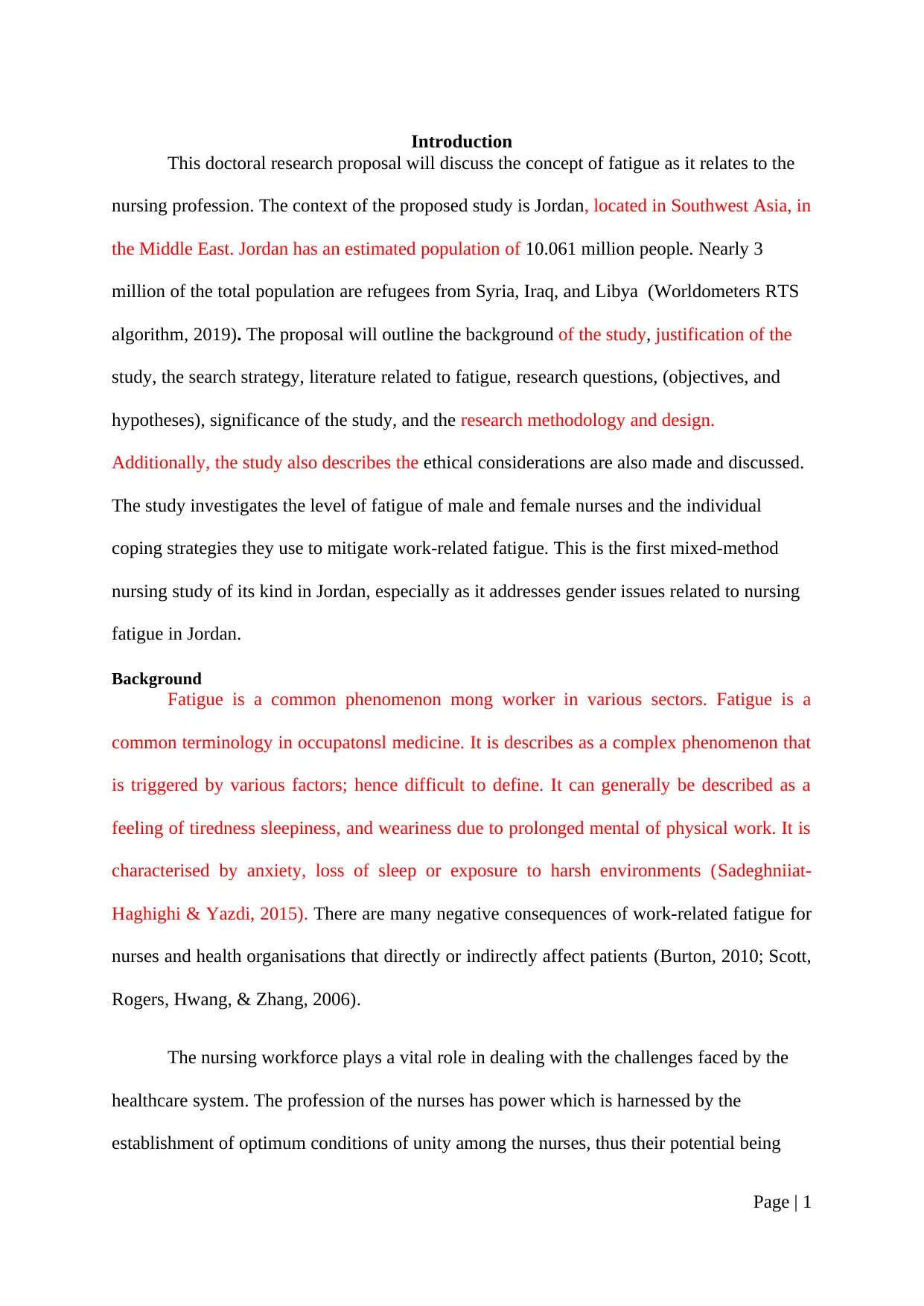
Introduction
This doctoral research proposal will discuss the concept of fatigue as it relates to the
nursing profession. The context of the proposed study is Jordan, located in Southwest Asia, in
the Middle East. Jordan has an estimated population of 10.061 million people. Nearly 3
million of the total population are refugees from Syria, Iraq, and Libya (Worldometers RTS
algorithm, 2019). The proposal will outline the background of the study, justification of the
study, the search strategy, literature related to fatigue, research questions, (objectives, and
hypotheses), significance of the study, and the research methodology and design.
Additionally, the study also describes the ethical considerations are also made and discussed.
The study investigates the level of fatigue of male and female nurses and the individual
coping strategies they use to mitigate work-related fatigue. This is the first mixed-method
nursing study of its kind in Jordan, especially as it addresses gender issues related to nursing
fatigue in Jordan.
Background
Fatigue is a common phenomenon mong worker in various sectors. Fatigue is a
common terminology in occupatonsl medicine. It is describes as a complex phenomenon that
is triggered by various factors; hence difficult to define. It can generally be described as a
feeling of tiredness sleepiness, and weariness due to prolonged mental of physical work. It is
characterised by anxiety, loss of sleep or exposure to harsh environments (Sadeghniiat-
Haghighi & Yazdi, 2015). There are many negative consequences of work-related fatigue for
nurses and health organisations that directly or indirectly affect patients (Burton, 2010; Scott,
Rogers, Hwang, & Zhang, 2006).
The nursing workforce plays a vital role in dealing with the challenges faced by the
healthcare system. The profession of the nurses has power which is harnessed by the
establishment of optimum conditions of unity among the nurses, thus their potential being
Page | 1
This doctoral research proposal will discuss the concept of fatigue as it relates to the
nursing profession. The context of the proposed study is Jordan, located in Southwest Asia, in
the Middle East. Jordan has an estimated population of 10.061 million people. Nearly 3
million of the total population are refugees from Syria, Iraq, and Libya (Worldometers RTS
algorithm, 2019). The proposal will outline the background of the study, justification of the
study, the search strategy, literature related to fatigue, research questions, (objectives, and
hypotheses), significance of the study, and the research methodology and design.
Additionally, the study also describes the ethical considerations are also made and discussed.
The study investigates the level of fatigue of male and female nurses and the individual
coping strategies they use to mitigate work-related fatigue. This is the first mixed-method
nursing study of its kind in Jordan, especially as it addresses gender issues related to nursing
fatigue in Jordan.
Background
Fatigue is a common phenomenon mong worker in various sectors. Fatigue is a
common terminology in occupatonsl medicine. It is describes as a complex phenomenon that
is triggered by various factors; hence difficult to define. It can generally be described as a
feeling of tiredness sleepiness, and weariness due to prolonged mental of physical work. It is
characterised by anxiety, loss of sleep or exposure to harsh environments (Sadeghniiat-
Haghighi & Yazdi, 2015). There are many negative consequences of work-related fatigue for
nurses and health organisations that directly or indirectly affect patients (Burton, 2010; Scott,
Rogers, Hwang, & Zhang, 2006).
The nursing workforce plays a vital role in dealing with the challenges faced by the
healthcare system. The profession of the nurses has power which is harnessed by the
establishment of optimum conditions of unity among the nurses, thus their potential being
Page | 1
Paraphrase This Document
Need a fresh take? Get an instant paraphrase of this document with our AI Paraphraser
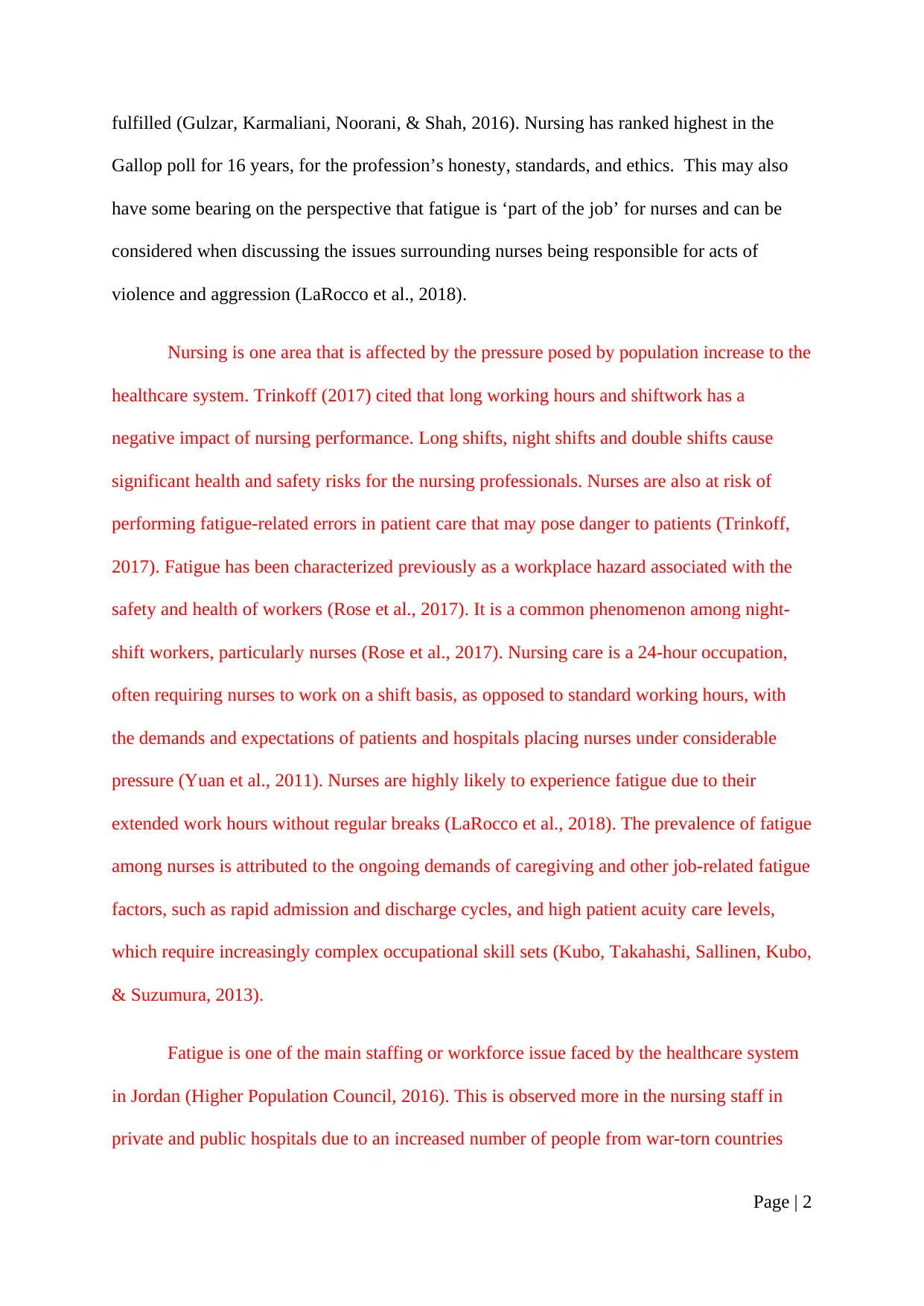
fulfilled (Gulzar, Karmaliani, Noorani, & Shah, 2016). Nursing has ranked highest in the
Gallop poll for 16 years, for the profession’s honesty, standards, and ethics. This may also
have some bearing on the perspective that fatigue is ‘part of the job’ for nurses and can be
considered when discussing the issues surrounding nurses being responsible for acts of
violence and aggression (LaRocco et al., 2018).
Nursing is one area that is affected by the pressure posed by population increase to the
healthcare system. Trinkoff (2017) cited that long working hours and shiftwork has a
negative impact of nursing performance. Long shifts, night shifts and double shifts cause
significant health and safety risks for the nursing professionals. Nurses are also at risk of
performing fatigue-related errors in patient care that may pose danger to patients (Trinkoff,
2017). Fatigue has been characterized previously as a workplace hazard associated with the
safety and health of workers (Rose et al., 2017). It is a common phenomenon among night-
shift workers, particularly nurses (Rose et al., 2017). Nursing care is a 24-hour occupation,
often requiring nurses to work on a shift basis, as opposed to standard working hours, with
the demands and expectations of patients and hospitals placing nurses under considerable
pressure (Yuan et al., 2011). Nurses are highly likely to experience fatigue due to their
extended work hours without regular breaks (LaRocco et al., 2018). The prevalence of fatigue
among nurses is attributed to the ongoing demands of caregiving and other job-related fatigue
factors, such as rapid admission and discharge cycles, and high patient acuity care levels,
which require increasingly complex occupational skill sets (Kubo, Takahashi, Sallinen, Kubo,
& Suzumura, 2013).
Fatigue is one of the main staffing or workforce issue faced by the healthcare system
in Jordan (Higher Population Council, 2016). This is observed more in the nursing staff in
private and public hospitals due to an increased number of people from war-torn countries
Page | 2
Gallop poll for 16 years, for the profession’s honesty, standards, and ethics. This may also
have some bearing on the perspective that fatigue is ‘part of the job’ for nurses and can be
considered when discussing the issues surrounding nurses being responsible for acts of
violence and aggression (LaRocco et al., 2018).
Nursing is one area that is affected by the pressure posed by population increase to the
healthcare system. Trinkoff (2017) cited that long working hours and shiftwork has a
negative impact of nursing performance. Long shifts, night shifts and double shifts cause
significant health and safety risks for the nursing professionals. Nurses are also at risk of
performing fatigue-related errors in patient care that may pose danger to patients (Trinkoff,
2017). Fatigue has been characterized previously as a workplace hazard associated with the
safety and health of workers (Rose et al., 2017). It is a common phenomenon among night-
shift workers, particularly nurses (Rose et al., 2017). Nursing care is a 24-hour occupation,
often requiring nurses to work on a shift basis, as opposed to standard working hours, with
the demands and expectations of patients and hospitals placing nurses under considerable
pressure (Yuan et al., 2011). Nurses are highly likely to experience fatigue due to their
extended work hours without regular breaks (LaRocco et al., 2018). The prevalence of fatigue
among nurses is attributed to the ongoing demands of caregiving and other job-related fatigue
factors, such as rapid admission and discharge cycles, and high patient acuity care levels,
which require increasingly complex occupational skill sets (Kubo, Takahashi, Sallinen, Kubo,
& Suzumura, 2013).
Fatigue is one of the main staffing or workforce issue faced by the healthcare system
in Jordan (Higher Population Council, 2016). This is observed more in the nursing staff in
private and public hospitals due to an increased number of people from war-torn countries
Page | 2
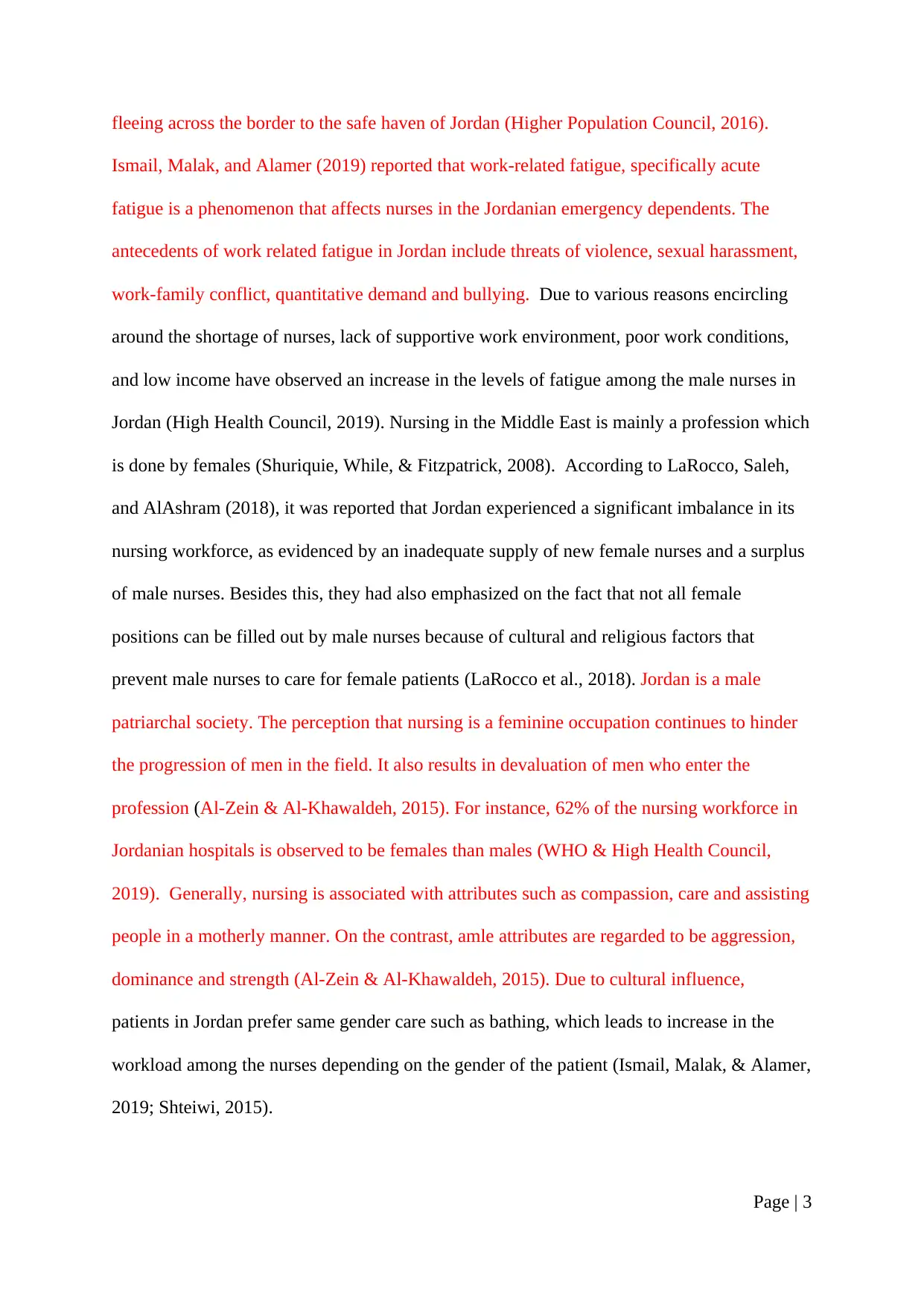
fleeing across the border to the safe haven of Jordan (Higher Population Council, 2016).
Ismail, Malak, and Alamer (2019) reported that work-related fatigue, specifically acute
fatigue is a phenomenon that affects nurses in the Jordanian emergency dependents. The
antecedents of work related fatigue in Jordan include threats of violence, sexual harassment,
work-family conflict, quantitative demand and bullying. Due to various reasons encircling
around the shortage of nurses, lack of supportive work environment, poor work conditions,
and low income have observed an increase in the levels of fatigue among the male nurses in
Jordan (High Health Council, 2019). Nursing in the Middle East is mainly a profession which
is done by females (Shuriquie, While, & Fitzpatrick, 2008). According to LaRocco, Saleh,
and AlAshram (2018), it was reported that Jordan experienced a significant imbalance in its
nursing workforce, as evidenced by an inadequate supply of new female nurses and a surplus
of male nurses. Besides this, they had also emphasized on the fact that not all female
positions can be filled out by male nurses because of cultural and religious factors that
prevent male nurses to care for female patients (LaRocco et al., 2018). Jordan is a male
patriarchal society. The perception that nursing is a feminine occupation continues to hinder
the progression of men in the field. It also results in devaluation of men who enter the
profession (Al-Zein & Al-Khawaldeh, 2015). For instance, 62% of the nursing workforce in
Jordanian hospitals is observed to be females than males (WHO & High Health Council,
2019). Generally, nursing is associated with attributes such as compassion, care and assisting
people in a motherly manner. On the contrast, amle attributes are regarded to be aggression,
dominance and strength (Al-Zein & Al-Khawaldeh, 2015). Due to cultural influence,
patients in Jordan prefer same gender care such as bathing, which leads to increase in the
workload among the nurses depending on the gender of the patient (Ismail, Malak, & Alamer,
2019; Shteiwi, 2015).
Page | 3
Ismail, Malak, and Alamer (2019) reported that work-related fatigue, specifically acute
fatigue is a phenomenon that affects nurses in the Jordanian emergency dependents. The
antecedents of work related fatigue in Jordan include threats of violence, sexual harassment,
work-family conflict, quantitative demand and bullying. Due to various reasons encircling
around the shortage of nurses, lack of supportive work environment, poor work conditions,
and low income have observed an increase in the levels of fatigue among the male nurses in
Jordan (High Health Council, 2019). Nursing in the Middle East is mainly a profession which
is done by females (Shuriquie, While, & Fitzpatrick, 2008). According to LaRocco, Saleh,
and AlAshram (2018), it was reported that Jordan experienced a significant imbalance in its
nursing workforce, as evidenced by an inadequate supply of new female nurses and a surplus
of male nurses. Besides this, they had also emphasized on the fact that not all female
positions can be filled out by male nurses because of cultural and religious factors that
prevent male nurses to care for female patients (LaRocco et al., 2018). Jordan is a male
patriarchal society. The perception that nursing is a feminine occupation continues to hinder
the progression of men in the field. It also results in devaluation of men who enter the
profession (Al-Zein & Al-Khawaldeh, 2015). For instance, 62% of the nursing workforce in
Jordanian hospitals is observed to be females than males (WHO & High Health Council,
2019). Generally, nursing is associated with attributes such as compassion, care and assisting
people in a motherly manner. On the contrast, amle attributes are regarded to be aggression,
dominance and strength (Al-Zein & Al-Khawaldeh, 2015). Due to cultural influence,
patients in Jordan prefer same gender care such as bathing, which leads to increase in the
workload among the nurses depending on the gender of the patient (Ismail, Malak, & Alamer,
2019; Shteiwi, 2015).
Page | 3
⊘ This is a preview!⊘
Do you want full access?
Subscribe today to unlock all pages.

Trusted by 1+ million students worldwide
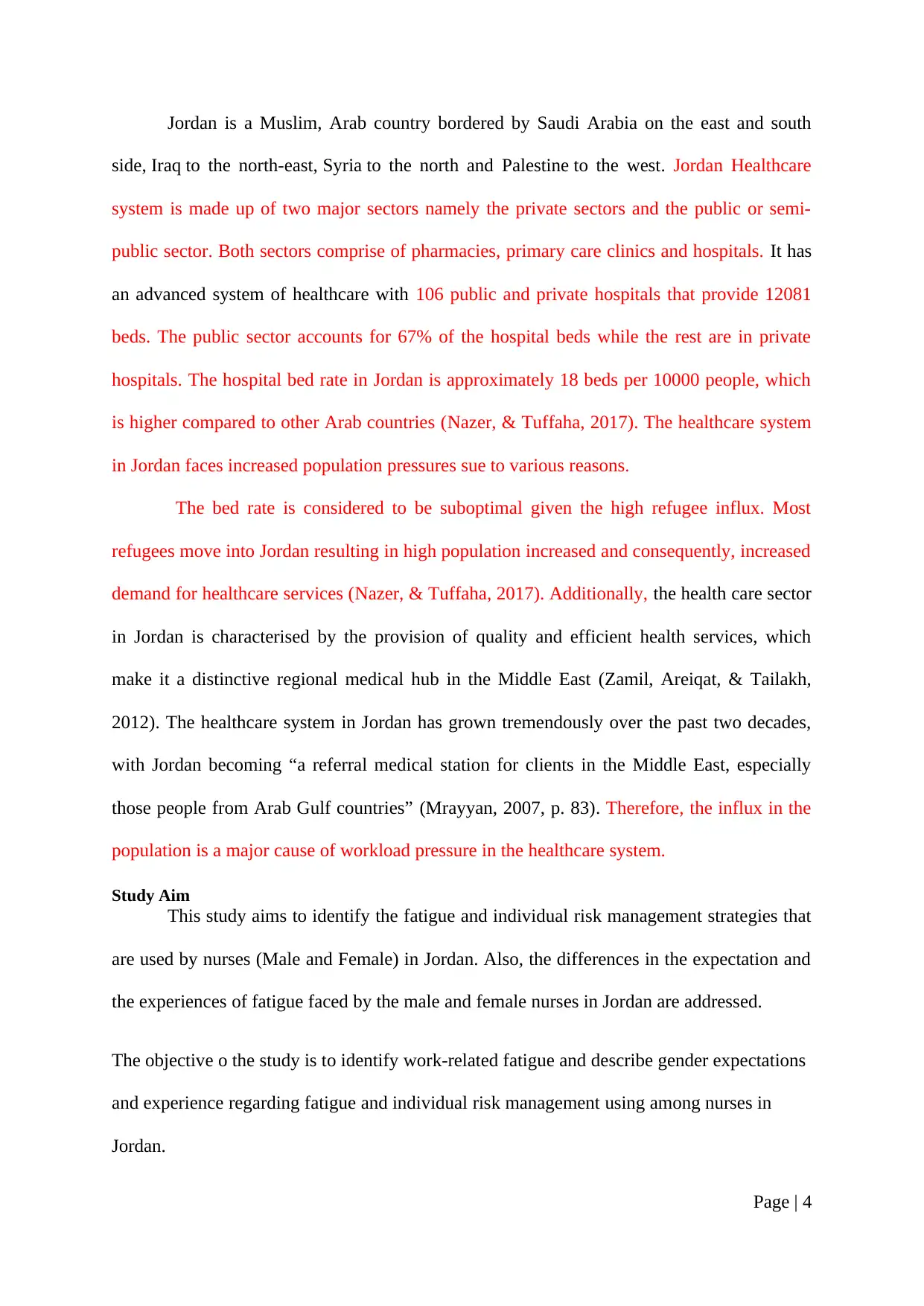
Jordan is a Muslim, Arab country bordered by Saudi Arabia on the east and south
side, Iraq to the north-east, Syria to the north and Palestine to the west. Jordan Healthcare
system is made up of two major sectors namely the private sectors and the public or semi-
public sector. Both sectors comprise of pharmacies, primary care clinics and hospitals. It has
an advanced system of healthcare with 106 public and private hospitals that provide 12081
beds. The public sector accounts for 67% of the hospital beds while the rest are in private
hospitals. The hospital bed rate in Jordan is approximately 18 beds per 10000 people, which
is higher compared to other Arab countries (Nazer, & Tuffaha, 2017). The healthcare system
in Jordan faces increased population pressures sue to various reasons.
The bed rate is considered to be suboptimal given the high refugee influx. Most
refugees move into Jordan resulting in high population increased and consequently, increased
demand for healthcare services (Nazer, & Tuffaha, 2017). Additionally, the health care sector
in Jordan is characterised by the provision of quality and efficient health services, which
make it a distinctive regional medical hub in the Middle East (Zamil, Areiqat, & Tailakh,
2012). The healthcare system in Jordan has grown tremendously over the past two decades,
with Jordan becoming “a referral medical station for clients in the Middle East, especially
those people from Arab Gulf countries” (Mrayyan, 2007, p. 83). Therefore, the influx in the
population is a major cause of workload pressure in the healthcare system.
Study Aim
This study aims to identify the fatigue and individual risk management strategies that
are used by nurses (Male and Female) in Jordan. Also, the differences in the expectation and
the experiences of fatigue faced by the male and female nurses in Jordan are addressed.
The objective o the study is to identify work-related fatigue and describe gender expectations
and experience regarding fatigue and individual risk management using among nurses in
Jordan.
Page | 4
side, Iraq to the north-east, Syria to the north and Palestine to the west. Jordan Healthcare
system is made up of two major sectors namely the private sectors and the public or semi-
public sector. Both sectors comprise of pharmacies, primary care clinics and hospitals. It has
an advanced system of healthcare with 106 public and private hospitals that provide 12081
beds. The public sector accounts for 67% of the hospital beds while the rest are in private
hospitals. The hospital bed rate in Jordan is approximately 18 beds per 10000 people, which
is higher compared to other Arab countries (Nazer, & Tuffaha, 2017). The healthcare system
in Jordan faces increased population pressures sue to various reasons.
The bed rate is considered to be suboptimal given the high refugee influx. Most
refugees move into Jordan resulting in high population increased and consequently, increased
demand for healthcare services (Nazer, & Tuffaha, 2017). Additionally, the health care sector
in Jordan is characterised by the provision of quality and efficient health services, which
make it a distinctive regional medical hub in the Middle East (Zamil, Areiqat, & Tailakh,
2012). The healthcare system in Jordan has grown tremendously over the past two decades,
with Jordan becoming “a referral medical station for clients in the Middle East, especially
those people from Arab Gulf countries” (Mrayyan, 2007, p. 83). Therefore, the influx in the
population is a major cause of workload pressure in the healthcare system.
Study Aim
This study aims to identify the fatigue and individual risk management strategies that
are used by nurses (Male and Female) in Jordan. Also, the differences in the expectation and
the experiences of fatigue faced by the male and female nurses in Jordan are addressed.
The objective o the study is to identify work-related fatigue and describe gender expectations
and experience regarding fatigue and individual risk management using among nurses in
Jordan.
Page | 4
Paraphrase This Document
Need a fresh take? Get an instant paraphrase of this document with our AI Paraphraser
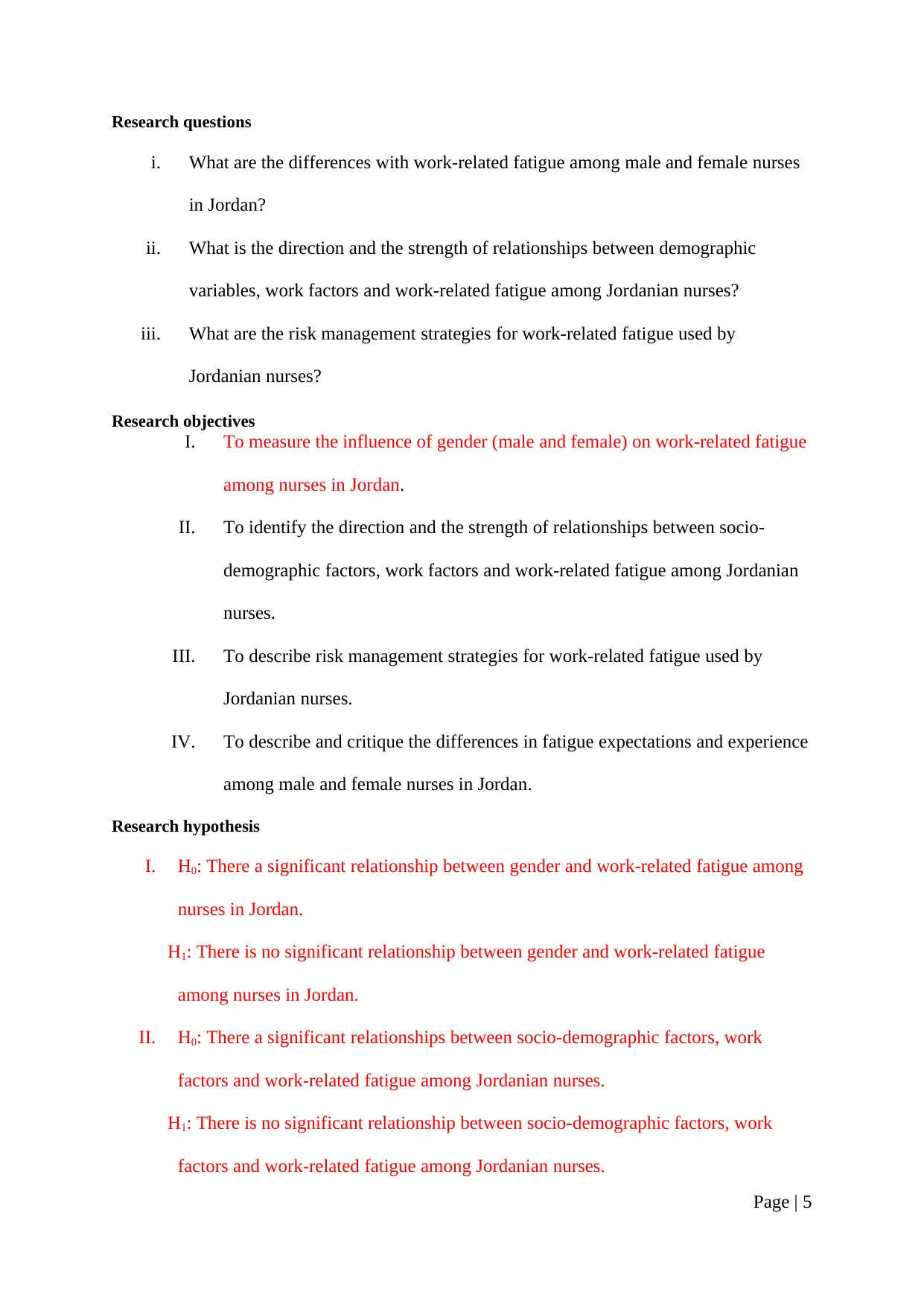
Research questions
i. What are the differences with work-related fatigue among male and female nurses
in Jordan?
ii. What is the direction and the strength of relationships between demographic
variables, work factors and work-related fatigue among Jordanian nurses?
iii. What are the risk management strategies for work-related fatigue used by
Jordanian nurses?
Research objectives
I. To measure the influence of gender (male and female) on work-related fatigue
among nurses in Jordan.
II. To identify the direction and the strength of relationships between socio-
demographic factors, work factors and work-related fatigue among Jordanian
nurses.
III. To describe risk management strategies for work-related fatigue used by
Jordanian nurses.
IV. To describe and critique the differences in fatigue expectations and experience
among male and female nurses in Jordan.
Research hypothesis
I. H0: There a significant relationship between gender and work-related fatigue among
nurses in Jordan.
H1: There is no significant relationship between gender and work-related fatigue
among nurses in Jordan.
II. H0: There a significant relationships between socio-demographic factors, work
factors and work-related fatigue among Jordanian nurses.
H1: There is no significant relationship between socio-demographic factors, work
factors and work-related fatigue among Jordanian nurses.
Page | 5
i. What are the differences with work-related fatigue among male and female nurses
in Jordan?
ii. What is the direction and the strength of relationships between demographic
variables, work factors and work-related fatigue among Jordanian nurses?
iii. What are the risk management strategies for work-related fatigue used by
Jordanian nurses?
Research objectives
I. To measure the influence of gender (male and female) on work-related fatigue
among nurses in Jordan.
II. To identify the direction and the strength of relationships between socio-
demographic factors, work factors and work-related fatigue among Jordanian
nurses.
III. To describe risk management strategies for work-related fatigue used by
Jordanian nurses.
IV. To describe and critique the differences in fatigue expectations and experience
among male and female nurses in Jordan.
Research hypothesis
I. H0: There a significant relationship between gender and work-related fatigue among
nurses in Jordan.
H1: There is no significant relationship between gender and work-related fatigue
among nurses in Jordan.
II. H0: There a significant relationships between socio-demographic factors, work
factors and work-related fatigue among Jordanian nurses.
H1: There is no significant relationship between socio-demographic factors, work
factors and work-related fatigue among Jordanian nurses.
Page | 5
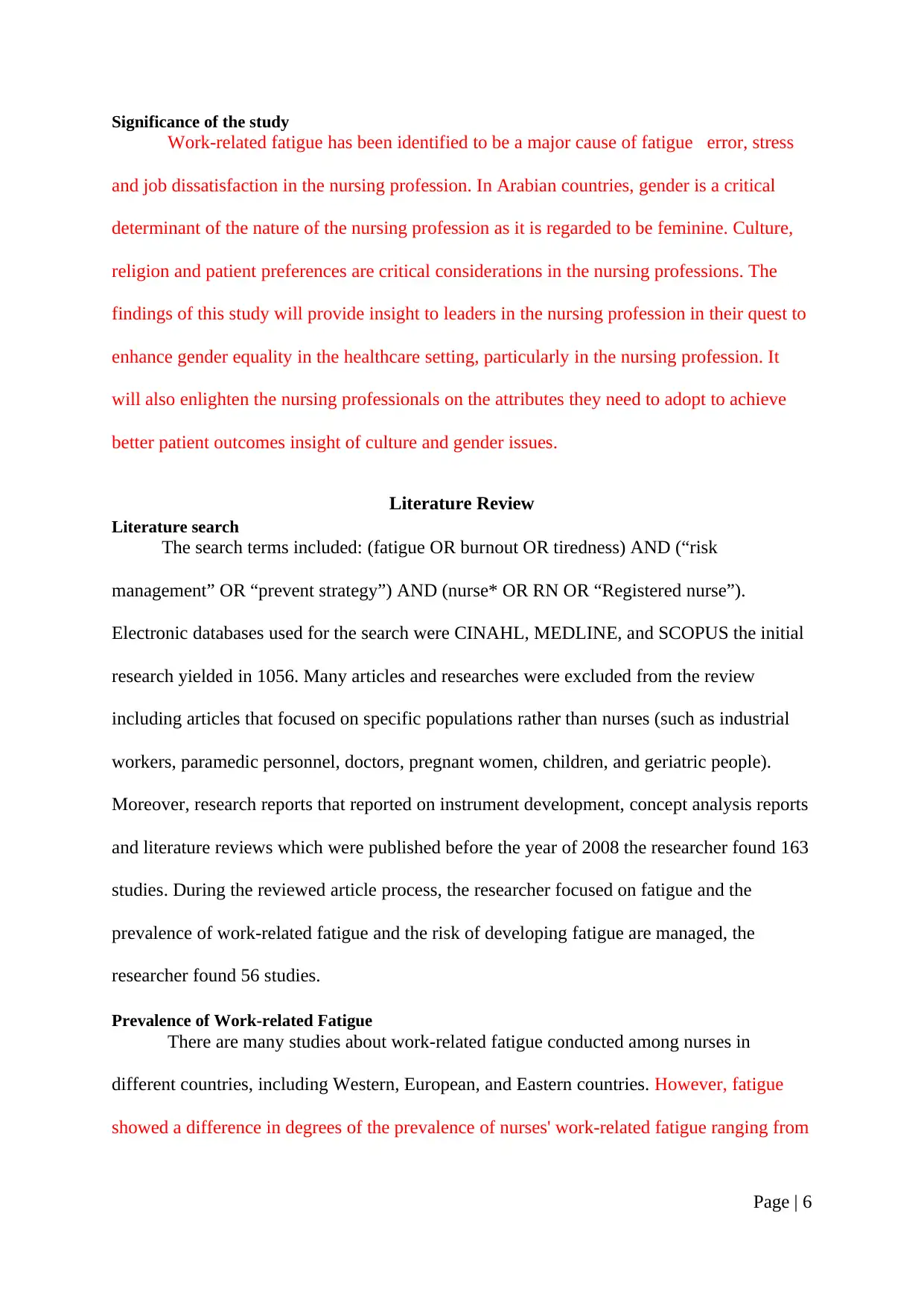
Significance of the study
Work-related fatigue has been identified to be a major cause of fatigue error, stress
and job dissatisfaction in the nursing profession. In Arabian countries, gender is a critical
determinant of the nature of the nursing profession as it is regarded to be feminine. Culture,
religion and patient preferences are critical considerations in the nursing professions. The
findings of this study will provide insight to leaders in the nursing profession in their quest to
enhance gender equality in the healthcare setting, particularly in the nursing profession. It
will also enlighten the nursing professionals on the attributes they need to adopt to achieve
better patient outcomes insight of culture and gender issues.
Literature Review
Literature search
The search terms included: (fatigue OR burnout OR tiredness) AND (“risk
management” OR “prevent strategy”) AND (nurse* OR RN OR “Registered nurse”).
Electronic databases used for the search were CINAHL, MEDLINE, and SCOPUS the initial
research yielded in 1056. Many articles and researches were excluded from the review
including articles that focused on specific populations rather than nurses (such as industrial
workers, paramedic personnel, doctors, pregnant women, children, and geriatric people).
Moreover, research reports that reported on instrument development, concept analysis reports
and literature reviews which were published before the year of 2008 the researcher found 163
studies. During the reviewed article process, the researcher focused on fatigue and the
prevalence of work-related fatigue and the risk of developing fatigue are managed, the
researcher found 56 studies.
Prevalence of Work-related Fatigue
There are many studies about work-related fatigue conducted among nurses in
different countries, including Western, European, and Eastern countries. However, fatigue
showed a difference in degrees of the prevalence of nurses' work-related fatigue ranging from
Page | 6
Work-related fatigue has been identified to be a major cause of fatigue error, stress
and job dissatisfaction in the nursing profession. In Arabian countries, gender is a critical
determinant of the nature of the nursing profession as it is regarded to be feminine. Culture,
religion and patient preferences are critical considerations in the nursing professions. The
findings of this study will provide insight to leaders in the nursing profession in their quest to
enhance gender equality in the healthcare setting, particularly in the nursing profession. It
will also enlighten the nursing professionals on the attributes they need to adopt to achieve
better patient outcomes insight of culture and gender issues.
Literature Review
Literature search
The search terms included: (fatigue OR burnout OR tiredness) AND (“risk
management” OR “prevent strategy”) AND (nurse* OR RN OR “Registered nurse”).
Electronic databases used for the search were CINAHL, MEDLINE, and SCOPUS the initial
research yielded in 1056. Many articles and researches were excluded from the review
including articles that focused on specific populations rather than nurses (such as industrial
workers, paramedic personnel, doctors, pregnant women, children, and geriatric people).
Moreover, research reports that reported on instrument development, concept analysis reports
and literature reviews which were published before the year of 2008 the researcher found 163
studies. During the reviewed article process, the researcher focused on fatigue and the
prevalence of work-related fatigue and the risk of developing fatigue are managed, the
researcher found 56 studies.
Prevalence of Work-related Fatigue
There are many studies about work-related fatigue conducted among nurses in
different countries, including Western, European, and Eastern countries. However, fatigue
showed a difference in degrees of the prevalence of nurses' work-related fatigue ranging from
Page | 6
⊘ This is a preview!⊘
Do you want full access?
Subscribe today to unlock all pages.

Trusted by 1+ million students worldwide
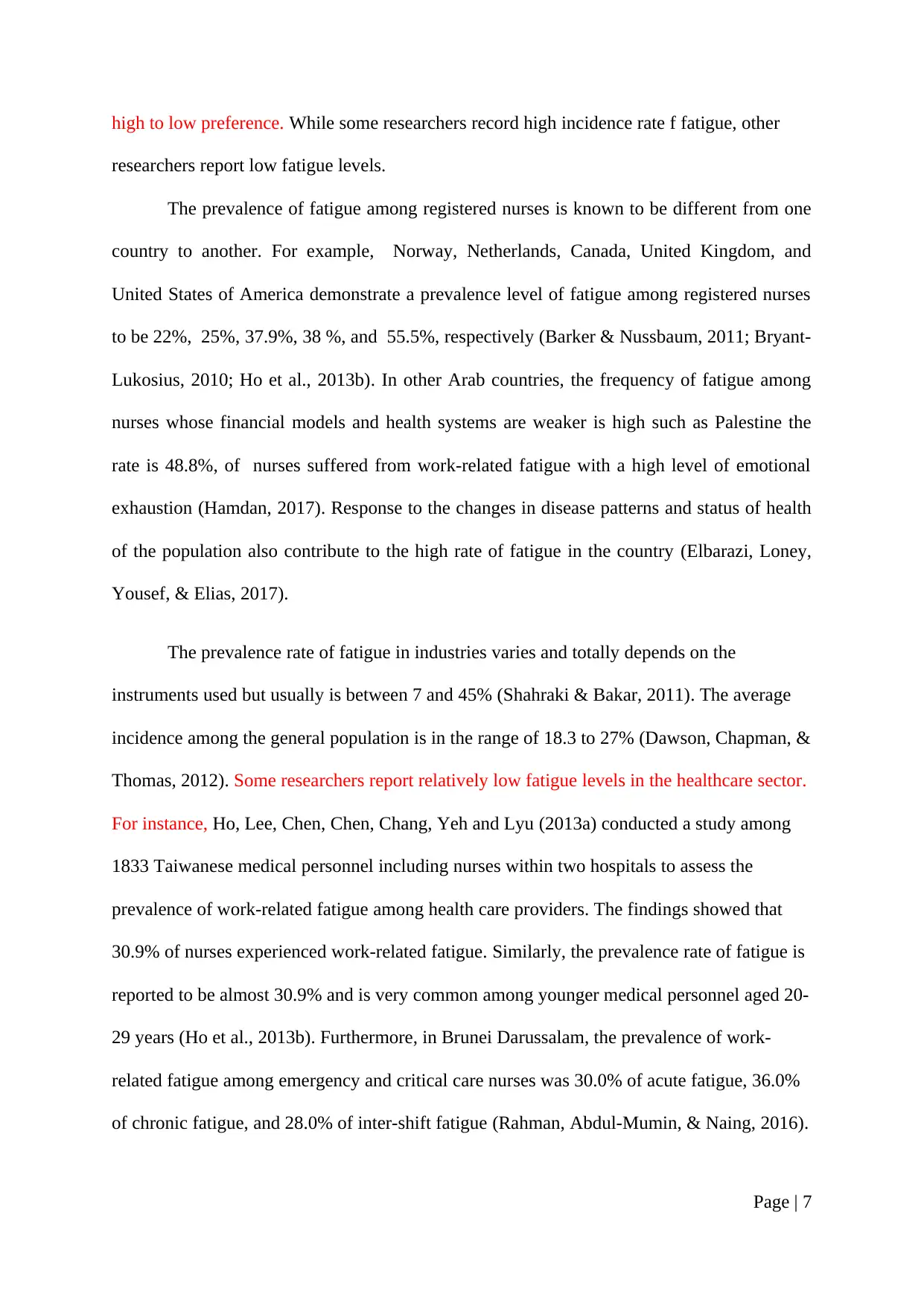
high to low preference. While some researchers record high incidence rate f fatigue, other
researchers report low fatigue levels.
The prevalence of fatigue among registered nurses is known to be different from one
country to another. For example, Norway, Netherlands, Canada, United Kingdom, and
United States of America demonstrate a prevalence level of fatigue among registered nurses
to be 22%, 25%, 37.9%, 38 %, and 55.5%, respectively (Barker & Nussbaum, 2011; Bryant-
Lukosius, 2010; Ho et al., 2013b). In other Arab countries, the frequency of fatigue among
nurses whose financial models and health systems are weaker is high such as Palestine the
rate is 48.8%, of nurses suffered from work-related fatigue with a high level of emotional
exhaustion (Hamdan, 2017). Response to the changes in disease patterns and status of health
of the population also contribute to the high rate of fatigue in the country (Elbarazi, Loney,
Yousef, & Elias, 2017).
The prevalence rate of fatigue in industries varies and totally depends on the
instruments used but usually is between 7 and 45% (Shahraki & Bakar, 2011). The average
incidence among the general population is in the range of 18.3 to 27% (Dawson, Chapman, &
Thomas, 2012). Some researchers report relatively low fatigue levels in the healthcare sector.
For instance, Ho, Lee, Chen, Chen, Chang, Yeh and Lyu (2013a) conducted a study among
1833 Taiwanese medical personnel including nurses within two hospitals to assess the
prevalence of work-related fatigue among health care providers. The findings showed that
30.9% of nurses experienced work-related fatigue. Similarly, the prevalence rate of fatigue is
reported to be almost 30.9% and is very common among younger medical personnel aged 20-
29 years (Ho et al., 2013b). Furthermore, in Brunei Darussalam, the prevalence of work-
related fatigue among emergency and critical care nurses was 30.0% of acute fatigue, 36.0%
of chronic fatigue, and 28.0% of inter-shift fatigue (Rahman, Abdul-Mumin, & Naing, 2016).
Page | 7
researchers report low fatigue levels.
The prevalence of fatigue among registered nurses is known to be different from one
country to another. For example, Norway, Netherlands, Canada, United Kingdom, and
United States of America demonstrate a prevalence level of fatigue among registered nurses
to be 22%, 25%, 37.9%, 38 %, and 55.5%, respectively (Barker & Nussbaum, 2011; Bryant-
Lukosius, 2010; Ho et al., 2013b). In other Arab countries, the frequency of fatigue among
nurses whose financial models and health systems are weaker is high such as Palestine the
rate is 48.8%, of nurses suffered from work-related fatigue with a high level of emotional
exhaustion (Hamdan, 2017). Response to the changes in disease patterns and status of health
of the population also contribute to the high rate of fatigue in the country (Elbarazi, Loney,
Yousef, & Elias, 2017).
The prevalence rate of fatigue in industries varies and totally depends on the
instruments used but usually is between 7 and 45% (Shahraki & Bakar, 2011). The average
incidence among the general population is in the range of 18.3 to 27% (Dawson, Chapman, &
Thomas, 2012). Some researchers report relatively low fatigue levels in the healthcare sector.
For instance, Ho, Lee, Chen, Chen, Chang, Yeh and Lyu (2013a) conducted a study among
1833 Taiwanese medical personnel including nurses within two hospitals to assess the
prevalence of work-related fatigue among health care providers. The findings showed that
30.9% of nurses experienced work-related fatigue. Similarly, the prevalence rate of fatigue is
reported to be almost 30.9% and is very common among younger medical personnel aged 20-
29 years (Ho et al., 2013b). Furthermore, in Brunei Darussalam, the prevalence of work-
related fatigue among emergency and critical care nurses was 30.0% of acute fatigue, 36.0%
of chronic fatigue, and 28.0% of inter-shift fatigue (Rahman, Abdul-Mumin, & Naing, 2016).
Page | 7
Paraphrase This Document
Need a fresh take? Get an instant paraphrase of this document with our AI Paraphraser
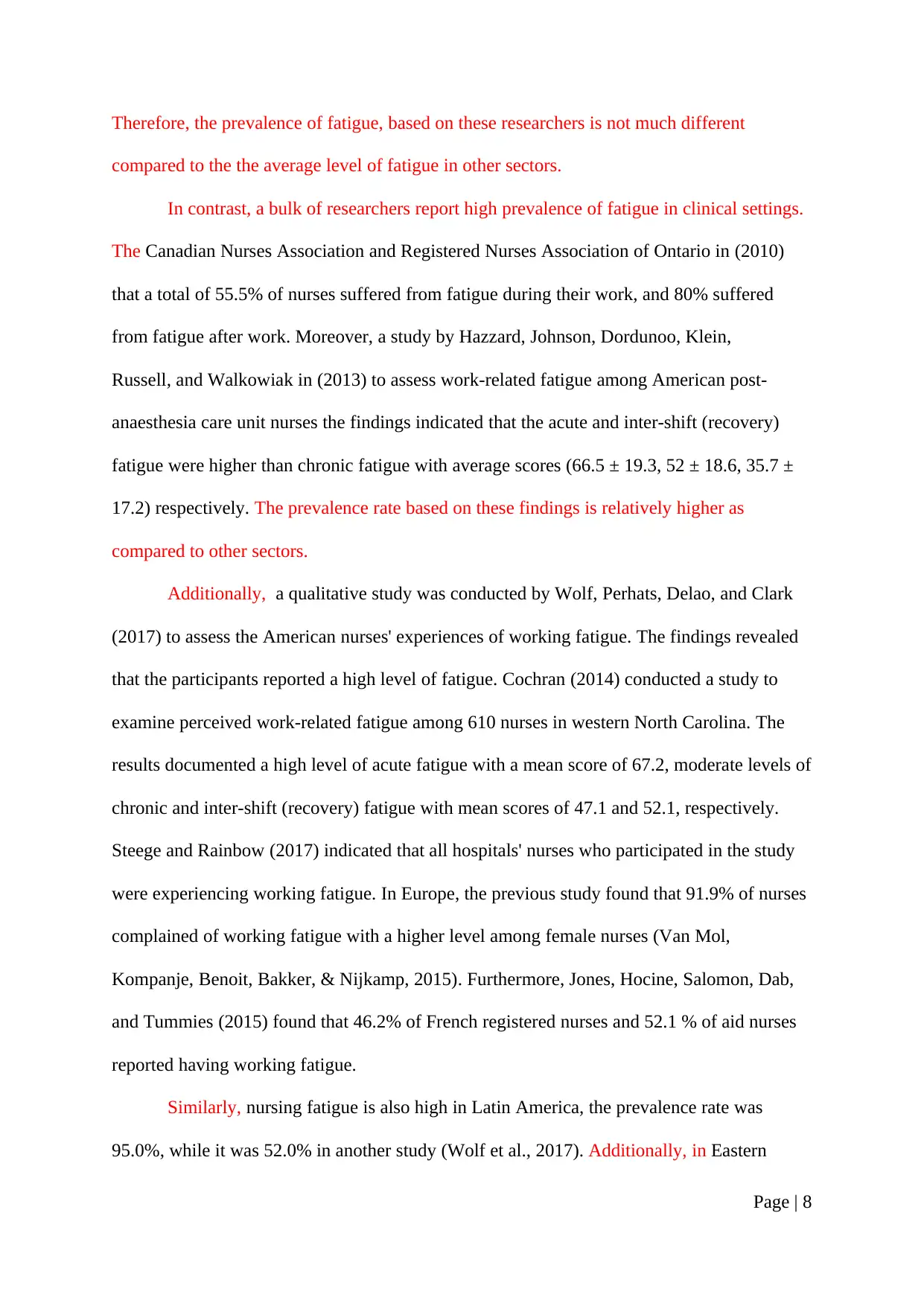
Therefore, the prevalence of fatigue, based on these researchers is not much different
compared to the the average level of fatigue in other sectors.
In contrast, a bulk of researchers report high prevalence of fatigue in clinical settings.
The Canadian Nurses Association and Registered Nurses Association of Ontario in (2010)
that a total of 55.5% of nurses suffered from fatigue during their work, and 80% suffered
from fatigue after work. Moreover, a study by Hazzard, Johnson, Dordunoo, Klein,
Russell, and Walkowiak in (2013) to assess work-related fatigue among American post-
anaesthesia care unit nurses the findings indicated that the acute and inter-shift (recovery)
fatigue were higher than chronic fatigue with average scores (66.5 ± 19.3, 52 ± 18.6, 35.7 ±
17.2) respectively. The prevalence rate based on these findings is relatively higher as
compared to other sectors.
Additionally, a qualitative study was conducted by Wolf, Perhats, Delao, and Clark
(2017) to assess the American nurses' experiences of working fatigue. The findings revealed
that the participants reported a high level of fatigue. Cochran (2014) conducted a study to
examine perceived work-related fatigue among 610 nurses in western North Carolina. The
results documented a high level of acute fatigue with a mean score of 67.2, moderate levels of
chronic and inter-shift (recovery) fatigue with mean scores of 47.1 and 52.1, respectively.
Steege and Rainbow (2017) indicated that all hospitals' nurses who participated in the study
were experiencing working fatigue. In Europe, the previous study found that 91.9% of nurses
complained of working fatigue with a higher level among female nurses (Van Mol,
Kompanje, Benoit, Bakker, & Nijkamp, 2015). Furthermore, Jones, Hocine, Salomon, Dab,
and Tummies (2015) found that 46.2% of French registered nurses and 52.1 % of aid nurses
reported having working fatigue.
Similarly, nursing fatigue is also high in Latin America, the prevalence rate was
95.0%, while it was 52.0% in another study (Wolf et al., 2017). Additionally, in Eastern
Page | 8
compared to the the average level of fatigue in other sectors.
In contrast, a bulk of researchers report high prevalence of fatigue in clinical settings.
The Canadian Nurses Association and Registered Nurses Association of Ontario in (2010)
that a total of 55.5% of nurses suffered from fatigue during their work, and 80% suffered
from fatigue after work. Moreover, a study by Hazzard, Johnson, Dordunoo, Klein,
Russell, and Walkowiak in (2013) to assess work-related fatigue among American post-
anaesthesia care unit nurses the findings indicated that the acute and inter-shift (recovery)
fatigue were higher than chronic fatigue with average scores (66.5 ± 19.3, 52 ± 18.6, 35.7 ±
17.2) respectively. The prevalence rate based on these findings is relatively higher as
compared to other sectors.
Additionally, a qualitative study was conducted by Wolf, Perhats, Delao, and Clark
(2017) to assess the American nurses' experiences of working fatigue. The findings revealed
that the participants reported a high level of fatigue. Cochran (2014) conducted a study to
examine perceived work-related fatigue among 610 nurses in western North Carolina. The
results documented a high level of acute fatigue with a mean score of 67.2, moderate levels of
chronic and inter-shift (recovery) fatigue with mean scores of 47.1 and 52.1, respectively.
Steege and Rainbow (2017) indicated that all hospitals' nurses who participated in the study
were experiencing working fatigue. In Europe, the previous study found that 91.9% of nurses
complained of working fatigue with a higher level among female nurses (Van Mol,
Kompanje, Benoit, Bakker, & Nijkamp, 2015). Furthermore, Jones, Hocine, Salomon, Dab,
and Tummies (2015) found that 46.2% of French registered nurses and 52.1 % of aid nurses
reported having working fatigue.
Similarly, nursing fatigue is also high in Latin America, the prevalence rate was
95.0%, while it was 52.0% in another study (Wolf et al., 2017). Additionally, in Eastern
Page | 8
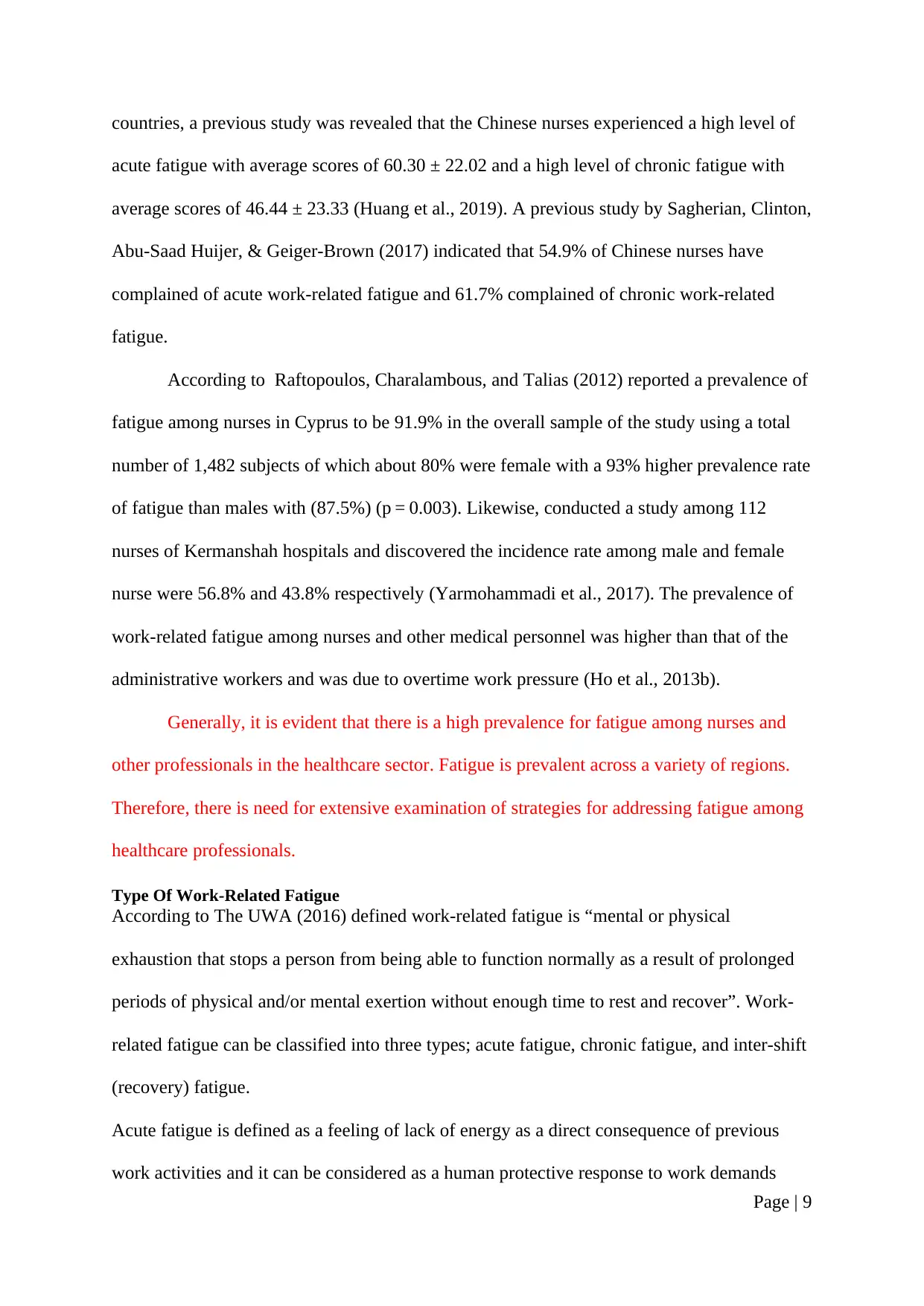
countries, a previous study was revealed that the Chinese nurses experienced a high level of
acute fatigue with average scores of 60.30 ± 22.02 and a high level of chronic fatigue with
average scores of 46.44 ± 23.33 (Huang et al., 2019). A previous study by Sagherian, Clinton,
Abu-Saad Huijer, & Geiger-Brown (2017) indicated that 54.9% of Chinese nurses have
complained of acute work-related fatigue and 61.7% complained of chronic work-related
fatigue.
According to Raftopoulos, Charalambous, and Talias (2012) reported a prevalence of
fatigue among nurses in Cyprus to be 91.9% in the overall sample of the study using a total
number of 1,482 subjects of which about 80% were female with a 93% higher prevalence rate
of fatigue than males with (87.5%) (p = 0.003). Likewise, conducted a study among 112
nurses of Kermanshah hospitals and discovered the incidence rate among male and female
nurse were 56.8% and 43.8% respectively (Yarmohammadi et al., 2017). The prevalence of
work-related fatigue among nurses and other medical personnel was higher than that of the
administrative workers and was due to overtime work pressure (Ho et al., 2013b).
Generally, it is evident that there is a high prevalence for fatigue among nurses and
other professionals in the healthcare sector. Fatigue is prevalent across a variety of regions.
Therefore, there is need for extensive examination of strategies for addressing fatigue among
healthcare professionals.
Type Of Work-Related Fatigue
According to The UWA (2016) defined work-related fatigue is “mental or physical
exhaustion that stops a person from being able to function normally as a result of prolonged
periods of physical and/or mental exertion without enough time to rest and recover”. Work-
related fatigue can be classified into three types; acute fatigue, chronic fatigue, and inter-shift
(recovery) fatigue.
Acute fatigue is defined as a feeling of lack of energy as a direct consequence of previous
work activities and it can be considered as a human protective response to work demands
Page | 9
acute fatigue with average scores of 60.30 ± 22.02 and a high level of chronic fatigue with
average scores of 46.44 ± 23.33 (Huang et al., 2019). A previous study by Sagherian, Clinton,
Abu-Saad Huijer, & Geiger-Brown (2017) indicated that 54.9% of Chinese nurses have
complained of acute work-related fatigue and 61.7% complained of chronic work-related
fatigue.
According to Raftopoulos, Charalambous, and Talias (2012) reported a prevalence of
fatigue among nurses in Cyprus to be 91.9% in the overall sample of the study using a total
number of 1,482 subjects of which about 80% were female with a 93% higher prevalence rate
of fatigue than males with (87.5%) (p = 0.003). Likewise, conducted a study among 112
nurses of Kermanshah hospitals and discovered the incidence rate among male and female
nurse were 56.8% and 43.8% respectively (Yarmohammadi et al., 2017). The prevalence of
work-related fatigue among nurses and other medical personnel was higher than that of the
administrative workers and was due to overtime work pressure (Ho et al., 2013b).
Generally, it is evident that there is a high prevalence for fatigue among nurses and
other professionals in the healthcare sector. Fatigue is prevalent across a variety of regions.
Therefore, there is need for extensive examination of strategies for addressing fatigue among
healthcare professionals.
Type Of Work-Related Fatigue
According to The UWA (2016) defined work-related fatigue is “mental or physical
exhaustion that stops a person from being able to function normally as a result of prolonged
periods of physical and/or mental exertion without enough time to rest and recover”. Work-
related fatigue can be classified into three types; acute fatigue, chronic fatigue, and inter-shift
(recovery) fatigue.
Acute fatigue is defined as a feeling of lack of energy as a direct consequence of previous
work activities and it can be considered as a human protective response to work demands
Page | 9
⊘ This is a preview!⊘
Do you want full access?
Subscribe today to unlock all pages.

Trusted by 1+ million students worldwide
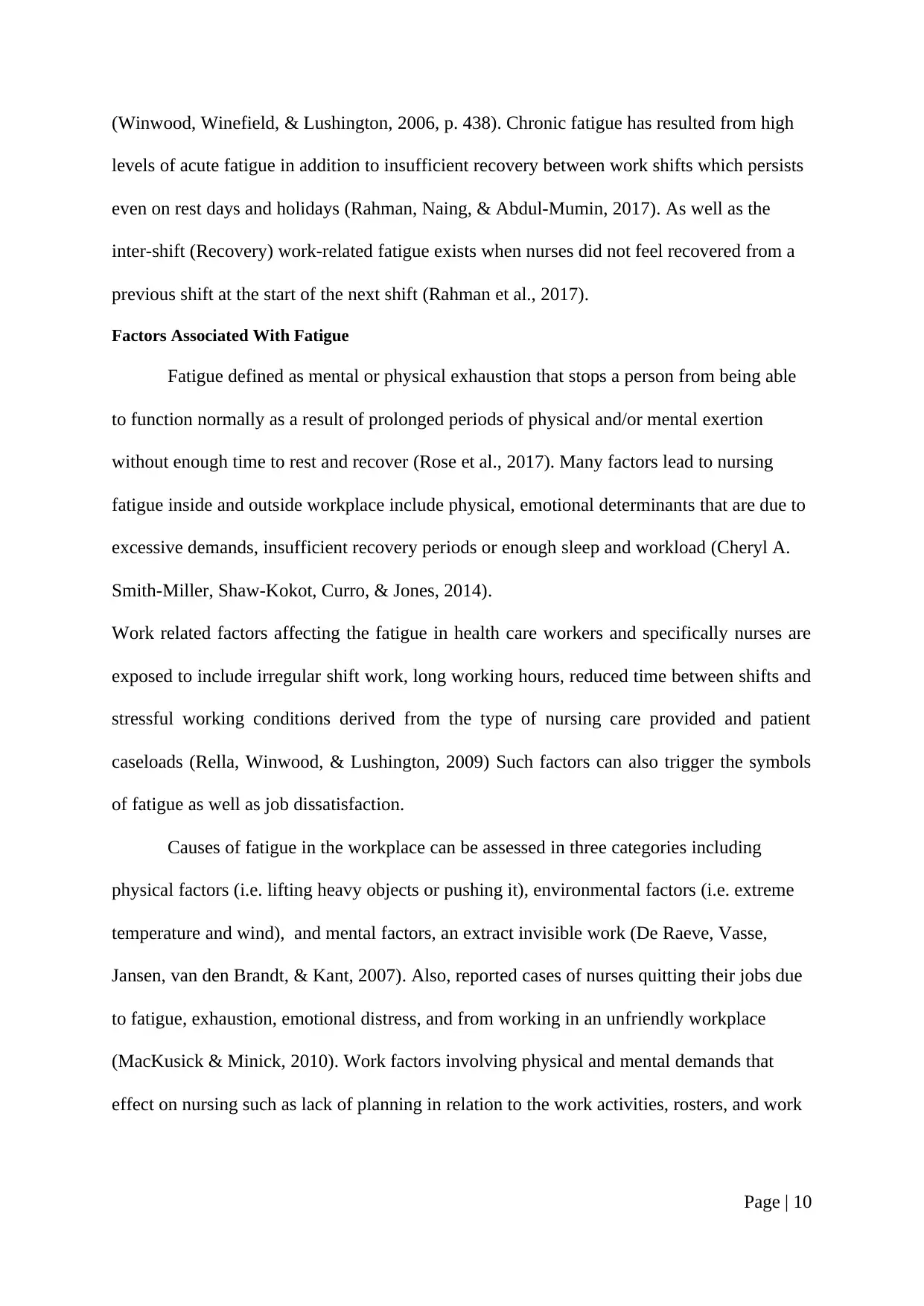
(Winwood, Winefield, & Lushington, 2006, p. 438). Chronic fatigue has resulted from high
levels of acute fatigue in addition to insufficient recovery between work shifts which persists
even on rest days and holidays (Rahman, Naing, & Abdul-Mumin, 2017). As well as the
inter-shift (Recovery) work-related fatigue exists when nurses did not feel recovered from a
previous shift at the start of the next shift (Rahman et al., 2017).
Factors Associated With Fatigue
Fatigue defined as mental or physical exhaustion that stops a person from being able
to function normally as a result of prolonged periods of physical and/or mental exertion
without enough time to rest and recover (Rose et al., 2017). Many factors lead to nursing
fatigue inside and outside workplace include physical, emotional determinants that are due to
excessive demands, insufficient recovery periods or enough sleep and workload (Cheryl A.
Smith-Miller, Shaw-Kokot, Curro, & Jones, 2014).
Work related factors affecting the fatigue in health care workers and specifically nurses are
exposed to include irregular shift work, long working hours, reduced time between shifts and
stressful working conditions derived from the type of nursing care provided and patient
caseloads (Rella, Winwood, & Lushington, 2009) Such factors can also trigger the symbols
of fatigue as well as job dissatisfaction.
Causes of fatigue in the workplace can be assessed in three categories including
physical factors (i.e. lifting heavy objects or pushing it), environmental factors (i.e. extreme
temperature and wind), and mental factors, an extract invisible work (De Raeve, Vasse,
Jansen, van den Brandt, & Kant, 2007). Also, reported cases of nurses quitting their jobs due
to fatigue, exhaustion, emotional distress, and from working in an unfriendly workplace
(MacKusick & Minick, 2010). Work factors involving physical and mental demands that
effect on nursing such as lack of planning in relation to the work activities, rosters, and work
Page | 10
levels of acute fatigue in addition to insufficient recovery between work shifts which persists
even on rest days and holidays (Rahman, Naing, & Abdul-Mumin, 2017). As well as the
inter-shift (Recovery) work-related fatigue exists when nurses did not feel recovered from a
previous shift at the start of the next shift (Rahman et al., 2017).
Factors Associated With Fatigue
Fatigue defined as mental or physical exhaustion that stops a person from being able
to function normally as a result of prolonged periods of physical and/or mental exertion
without enough time to rest and recover (Rose et al., 2017). Many factors lead to nursing
fatigue inside and outside workplace include physical, emotional determinants that are due to
excessive demands, insufficient recovery periods or enough sleep and workload (Cheryl A.
Smith-Miller, Shaw-Kokot, Curro, & Jones, 2014).
Work related factors affecting the fatigue in health care workers and specifically nurses are
exposed to include irregular shift work, long working hours, reduced time between shifts and
stressful working conditions derived from the type of nursing care provided and patient
caseloads (Rella, Winwood, & Lushington, 2009) Such factors can also trigger the symbols
of fatigue as well as job dissatisfaction.
Causes of fatigue in the workplace can be assessed in three categories including
physical factors (i.e. lifting heavy objects or pushing it), environmental factors (i.e. extreme
temperature and wind), and mental factors, an extract invisible work (De Raeve, Vasse,
Jansen, van den Brandt, & Kant, 2007). Also, reported cases of nurses quitting their jobs due
to fatigue, exhaustion, emotional distress, and from working in an unfriendly workplace
(MacKusick & Minick, 2010). Work factors involving physical and mental demands that
effect on nursing such as lack of planning in relation to the work activities, rosters, and work
Page | 10
Paraphrase This Document
Need a fresh take? Get an instant paraphrase of this document with our AI Paraphraser
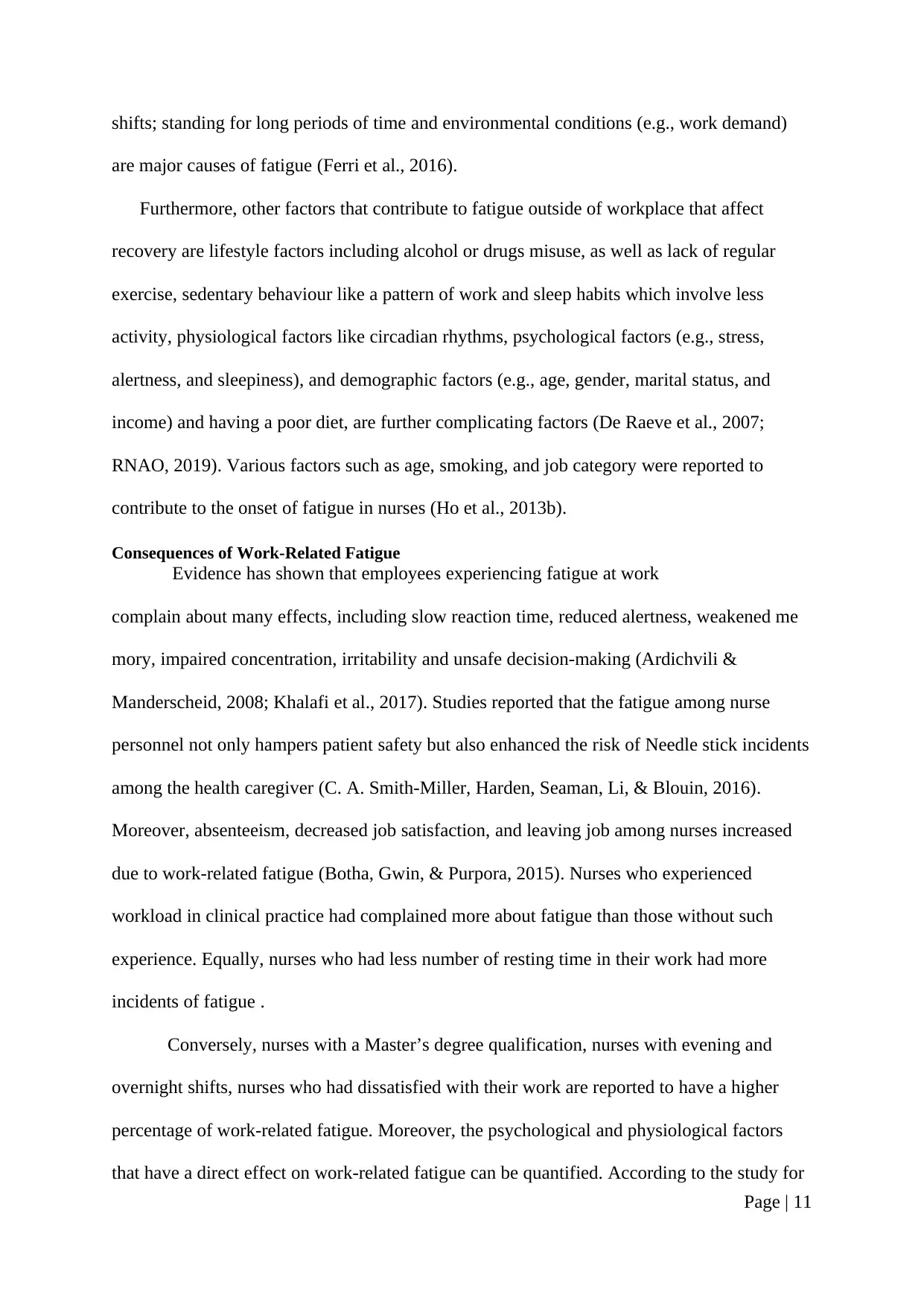
shifts; standing for long periods of time and environmental conditions (e.g., work demand)
are major causes of fatigue (Ferri et al., 2016).
Furthermore, other factors that contribute to fatigue outside of workplace that affect
recovery are lifestyle factors including alcohol or drugs misuse, as well as lack of regular
exercise, sedentary behaviour like a pattern of work and sleep habits which involve less
activity, physiological factors like circadian rhythms, psychological factors (e.g., stress,
alertness, and sleepiness), and demographic factors (e.g., age, gender, marital status, and
income) and having a poor diet, are further complicating factors (De Raeve et al., 2007;
RNAO, 2019). Various factors such as age, smoking, and job category were reported to
contribute to the onset of fatigue in nurses (Ho et al., 2013b).
Consequences of Work-Related Fatigue
Evidence has shown that employees experiencing fatigue at work
complain about many effects, including slow reaction time, reduced alertness, weakened me
mory, impaired concentration, irritability and unsafe decision-making (Ardichvili &
Manderscheid, 2008; Khalafi et al., 2017). Studies reported that the fatigue among nurse
personnel not only hampers patient safety but also enhanced the risk of Needle stick incidents
among the health caregiver (C. A. Smith-Miller, Harden, Seaman, Li, & Blouin, 2016).
Moreover, absenteeism, decreased job satisfaction, and leaving job among nurses increased
due to work-related fatigue (Botha, Gwin, & Purpora, 2015). Nurses who experienced
workload in clinical practice had complained more about fatigue than those without such
experience. Equally, nurses who had less number of resting time in their work had more
incidents of fatigue .
Conversely, nurses with a Master’s degree qualification, nurses with evening and
overnight shifts, nurses who had dissatisfied with their work are reported to have a higher
percentage of work-related fatigue. Moreover, the psychological and physiological factors
that have a direct effect on work-related fatigue can be quantified. According to the study for
Page | 11
are major causes of fatigue (Ferri et al., 2016).
Furthermore, other factors that contribute to fatigue outside of workplace that affect
recovery are lifestyle factors including alcohol or drugs misuse, as well as lack of regular
exercise, sedentary behaviour like a pattern of work and sleep habits which involve less
activity, physiological factors like circadian rhythms, psychological factors (e.g., stress,
alertness, and sleepiness), and demographic factors (e.g., age, gender, marital status, and
income) and having a poor diet, are further complicating factors (De Raeve et al., 2007;
RNAO, 2019). Various factors such as age, smoking, and job category were reported to
contribute to the onset of fatigue in nurses (Ho et al., 2013b).
Consequences of Work-Related Fatigue
Evidence has shown that employees experiencing fatigue at work
complain about many effects, including slow reaction time, reduced alertness, weakened me
mory, impaired concentration, irritability and unsafe decision-making (Ardichvili &
Manderscheid, 2008; Khalafi et al., 2017). Studies reported that the fatigue among nurse
personnel not only hampers patient safety but also enhanced the risk of Needle stick incidents
among the health caregiver (C. A. Smith-Miller, Harden, Seaman, Li, & Blouin, 2016).
Moreover, absenteeism, decreased job satisfaction, and leaving job among nurses increased
due to work-related fatigue (Botha, Gwin, & Purpora, 2015). Nurses who experienced
workload in clinical practice had complained more about fatigue than those without such
experience. Equally, nurses who had less number of resting time in their work had more
incidents of fatigue .
Conversely, nurses with a Master’s degree qualification, nurses with evening and
overnight shifts, nurses who had dissatisfied with their work are reported to have a higher
percentage of work-related fatigue. Moreover, the psychological and physiological factors
that have a direct effect on work-related fatigue can be quantified. According to the study for
Page | 11
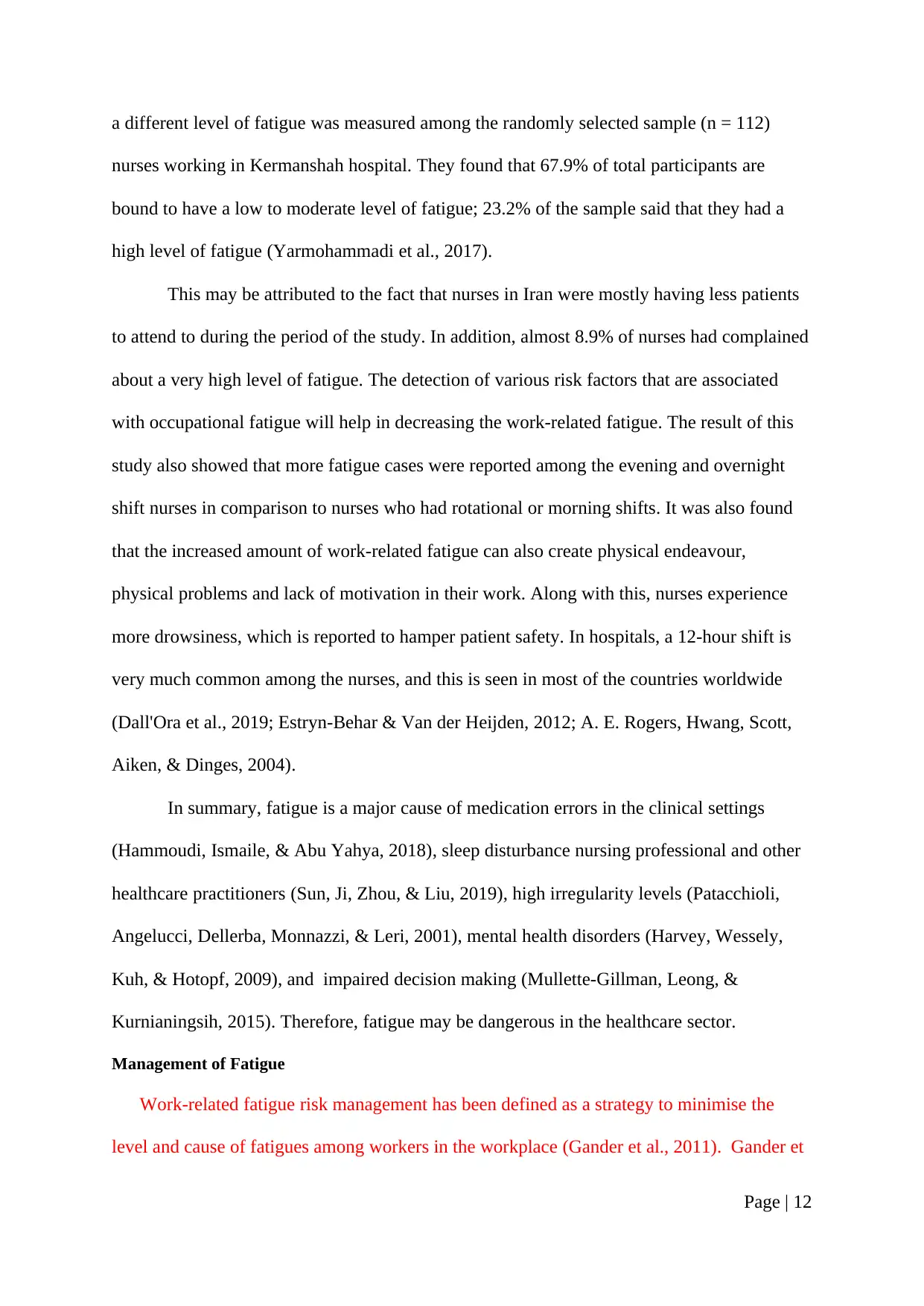
a different level of fatigue was measured among the randomly selected sample (n = 112)
nurses working in Kermanshah hospital. They found that 67.9% of total participants are
bound to have a low to moderate level of fatigue; 23.2% of the sample said that they had a
high level of fatigue (Yarmohammadi et al., 2017).
This may be attributed to the fact that nurses in Iran were mostly having less patients
to attend to during the period of the study. In addition, almost 8.9% of nurses had complained
about a very high level of fatigue. The detection of various risk factors that are associated
with occupational fatigue will help in decreasing the work-related fatigue. The result of this
study also showed that more fatigue cases were reported among the evening and overnight
shift nurses in comparison to nurses who had rotational or morning shifts. It was also found
that the increased amount of work-related fatigue can also create physical endeavour,
physical problems and lack of motivation in their work. Along with this, nurses experience
more drowsiness, which is reported to hamper patient safety. In hospitals, a 12-hour shift is
very much common among the nurses, and this is seen in most of the countries worldwide
(Dall'Ora et al., 2019; Estryn-Behar & Van der Heijden, 2012; A. E. Rogers, Hwang, Scott,
Aiken, & Dinges, 2004).
In summary, fatigue is a major cause of medication errors in the clinical settings
(Hammoudi, Ismaile, & Abu Yahya, 2018), sleep disturbance nursing professional and other
healthcare practitioners (Sun, Ji, Zhou, & Liu, 2019), high irregularity levels (Patacchioli,
Angelucci, Dellerba, Monnazzi, & Leri, 2001), mental health disorders (Harvey, Wessely,
Kuh, & Hotopf, 2009), and impaired decision making (Mullette-Gillman, Leong, &
Kurnianingsih, 2015). Therefore, fatigue may be dangerous in the healthcare sector.
Management of Fatigue
Work-related fatigue risk management has been defined as a strategy to minimise the
level and cause of fatigues among workers in the workplace (Gander et al., 2011). Gander et
Page | 12
nurses working in Kermanshah hospital. They found that 67.9% of total participants are
bound to have a low to moderate level of fatigue; 23.2% of the sample said that they had a
high level of fatigue (Yarmohammadi et al., 2017).
This may be attributed to the fact that nurses in Iran were mostly having less patients
to attend to during the period of the study. In addition, almost 8.9% of nurses had complained
about a very high level of fatigue. The detection of various risk factors that are associated
with occupational fatigue will help in decreasing the work-related fatigue. The result of this
study also showed that more fatigue cases were reported among the evening and overnight
shift nurses in comparison to nurses who had rotational or morning shifts. It was also found
that the increased amount of work-related fatigue can also create physical endeavour,
physical problems and lack of motivation in their work. Along with this, nurses experience
more drowsiness, which is reported to hamper patient safety. In hospitals, a 12-hour shift is
very much common among the nurses, and this is seen in most of the countries worldwide
(Dall'Ora et al., 2019; Estryn-Behar & Van der Heijden, 2012; A. E. Rogers, Hwang, Scott,
Aiken, & Dinges, 2004).
In summary, fatigue is a major cause of medication errors in the clinical settings
(Hammoudi, Ismaile, & Abu Yahya, 2018), sleep disturbance nursing professional and other
healthcare practitioners (Sun, Ji, Zhou, & Liu, 2019), high irregularity levels (Patacchioli,
Angelucci, Dellerba, Monnazzi, & Leri, 2001), mental health disorders (Harvey, Wessely,
Kuh, & Hotopf, 2009), and impaired decision making (Mullette-Gillman, Leong, &
Kurnianingsih, 2015). Therefore, fatigue may be dangerous in the healthcare sector.
Management of Fatigue
Work-related fatigue risk management has been defined as a strategy to minimise the
level and cause of fatigues among workers in the workplace (Gander et al., 2011). Gander et
Page | 12
⊘ This is a preview!⊘
Do you want full access?
Subscribe today to unlock all pages.

Trusted by 1+ million students worldwide
1 out of 49
Related Documents
Your All-in-One AI-Powered Toolkit for Academic Success.
+13062052269
info@desklib.com
Available 24*7 on WhatsApp / Email
![[object Object]](/_next/static/media/star-bottom.7253800d.svg)
Unlock your academic potential
Copyright © 2020–2025 A2Z Services. All Rights Reserved. Developed and managed by ZUCOL.





